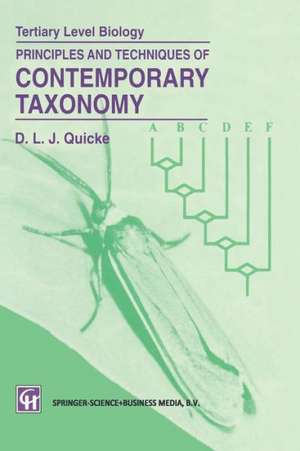Principles and Techniques of Contemporary Taxonomy: Experimental and Clinical Neuroscience
Editat de Donald L.J. Quickeen Limba Engleză Paperback – 3 oct 2013
Preț: 584.58 lei
Preț vechi: 687.74 lei
-15% Nou
Puncte Express: 877
Preț estimativ în valută:
111.87€ • 116.13$ • 93.28£
111.87€ • 116.13$ • 93.28£
Carte tipărită la comandă
Livrare economică 22 martie-05 aprilie
Preluare comenzi: 021 569.72.76
Specificații
ISBN-13: 9789401049450
ISBN-10: 9401049459
Pagini: 324
Ilustrații: XII, 311 p.
Dimensiuni: 152 x 229 x 17 mm
Greutate: 0.44 kg
Ediția:Softcover reprint of the original 1st ed. 1993
Editura: SPRINGER NETHERLANDS
Colecția Springer
Seria Experimental and Clinical Neuroscience
Locul publicării:Dordrecht, Netherlands
ISBN-10: 9401049459
Pagini: 324
Ilustrații: XII, 311 p.
Dimensiuni: 152 x 229 x 17 mm
Greutate: 0.44 kg
Ediția:Softcover reprint of the original 1st ed. 1993
Editura: SPRINGER NETHERLANDS
Colecția Springer
Seria Experimental and Clinical Neuroscience
Locul publicării:Dordrecht, Netherlands
Public țintă
ResearchCuprins
1 Introduction.- 1.1 The compass of taxonomy and systematics.- 1.2 The 1960s and the emergence of new ideas.- 1.3 Cladistics and numerical taxonomy: the conflict.- 1.4 Assumptions and philosophy of cladistics and the use of parsimony criteria.- 1.5 Taxonomy and the comparative method in biology.- 2 Characters, Taxa and Species.- 2.1 Nature and handling of data.- 2.2 Characters.- 2.3 Classes of characters requiring special consideration.- 2.4 Taxa and species concepts.- 2.5 What is a species?.- 3 Phylogenetic Reconstruction — Cladistics and Related Methods.- 3.1 Cladistics and cladograms.- 3.2 Parsimony and finding the shortest trees.- 3.3 Which method? — an overview.- 3.4 Cladistics and classification.- 4 Phenetic Methods in Taxonomy.- 4.1 Introduction.- 4.2 Analysing similarity and distance data.- 4.3 Hierarchic clustering procedures.- 4.4 Ordination methods.- 5 Keys and Identification.- 5.1 Introduction.- 5.2 Types of keys.- 5.3 Efficiency.- 5.4 Computerized key construction.- 6 Nomenclature and Classification.- 6.1 Introduction.- 6.2 The binomial system and the hierarchy of taxa.- 6.3 The International Commissions.- 6.4 Basic principles of nomenclature.- 6.5 Miscellaneous group-related factors.- 6.6 Names of higher groups.- 6.7 Starting dates for nomenclature.- 6.8 Citation of authors.- 6.9 Publication.- 6.10 Type depositories.- 6.11 Good practice.- 6.12 Major taxonomic publications.- 7 Cytotaxonomy.- 7.1 Introduction.- 7.2 Karyotypes.- 7.3 Chromosome banding.- 7.4 Chiasma frequency.- 7.5 Inversions. translocations and their significance.- 7.6In situhybridization.- 8 Chemotaxonomy and Related Topics.- 8.1 Origins of chemotaxonomy.- 8.2 Classes of compounds and their biological significance.- 8.3 Fermentation properties and drug resistance in microorganisms.- 8.4The use of chemical data.- 9 Immunotaxonomy.- 9.1 History.- 9.2 Precipitin reaction.- 9.3 Immunodiffusion.- 9.4 Immunoelectrophoresis.- 9.5 Microcomplement fixation (MC’F).- 9.6 Use of monoclonal antibodies.- 9.7 Radioimmunoassay.- 9.8 Analysis of immunological data.- 10 Proteins and Taxonomy.- 10.1 Introduction.- 10.2 Techniques of protein electrophoresis.- 10.3 Systematic aspects of electrophoresis.- 10.4 Chemical protein analysis procedures.- 10.5 Analysis of amino acid sequence data.- 11 Nucleic Acid Methods.- 11.1 Nucleic acids in taxonomy.- 11.2 Nucleic acids in cells.- 11.3 Amplifying DNA and dealing with small samples.- 11.4 G+C content.- 11.5 Restriction fragment analysis.- 11.6 DNA hybridization.- 11.7 Sequencing and associated methods.- 11.8 Conservation versus variability.- 11.9 Analysing sequence data.- 11.10 Pros and cons of hybridization and sequencing.- 11.11 Fossil DNA.- 12 Palaeotaxonomy, Biogeography, Evolution and Extinction.- 12.1 Palaeotaxonomy.- 12.2 Biogeography.- 12.3 Coevolution.- 12.4 Phylogenetic trees and the pattern of evolution.- 13 Museums, Herbaria, Biodiversity, Conservation and the Future of Taxonomy.- 13.1 Museums and their roles.- 13.2 The future of taxonomy.



















